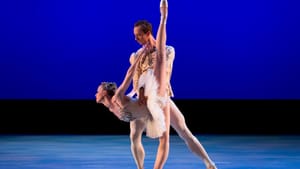Stay in the Loop
BSR publishes on a weekly schedule, with an email newsletter every Wednesday and Thursday morning. There’s no paywall, and subscribing is always free.
Stellar dance
Annenberg Center Live and NextMove Dance present Stars of American Ballet

The stars came out at the Annenberg Center as nine dancers performed a mixed program in styles ranging from classical ballet to energetic dances that drew upon ballroom, jazz, and more. Stars of American Ballet is a company founded and directed by Daniel Ulbricht, a dancer whose quick rise from Florida kid to New York City Ballet principal earned him the nickname “the Billy Elliot of St. Petersburg.” Like Ulbricht, most of the other dancers are affiliated with New York City Ballet, and it was a treat to see the singular talents of this world-renowned company in University City.
Disjointed yet repetitive
The program’s pace was quick, with a runtime under 90 minutes, featuring short dances and excerpts from longer works for one to three performers. Ulbricht seemed to aim for diversity, including several works by George Balanchine alongside pieces choreographed by Christopher Wheeldon, Alexei Ratmansky, and Stars of American Ballet dancers with musical accompaniment ranging from classical to jazz. The overall effect, however, was more similarity than diversity.
For instance, both the first and second act contained a series of ballet duets followed by a showy, crowd-pleasing number. The controlled elegance of the former contrasted with the exuberant energy of the latter. While it showed the dancers’ skills in a range of styles, it also made for a disjointed yet sometimes repetitive program.
Stunning shapes seem easy
The first act began with Balanchine’s “Tarantella” (1964), a demanding pas de deux danced here by Ulbricht and Kristen Segin. The couple embodied playful energy as they clapped their hands together, tilted their heads, and rattled tambourines. Ulbricht leapt sky-high with flawless batterie in his solo sections, while Segin swung a leg behind her body at an impressive vertical angle.
Next, Teresa Reichlen and Ask la Cour danced Wheeldon’s “Liturgy” (2003), a contemplative ballet in a contemporary style. The piece began and ended in near darkness, portraying a couple who seemed to emerge from the shadows before returning to them. Similarly, the “Liturgy" dancers moved toward and away from each other. Reichlen and la Cour formed striking shapes with their bodies, especially in their many balancing moves. They created the illusion of weightlessness as la Cour steadied Reichlen’s upside-down body, her weight balanced on one hand. Moments like these highlight ballet’s singular capacity for creating stunning shapes with seeming ease as dancers draw on their athleticism and endurance to conceal any sign of strain.
Sterling Hyltin and Adrian Danchig-Waring performed one of the evening’s standouts, Balachine’s “Apollo Pas de Deux” (1924). Danchig-Waring was a commanding Apollo, and Hyltin shone brightest among a group of elite dancers. She showed exceptional grace in a series of single-leg balances and later appeared weightless as she balanced across her partner’s neck and shoulders while he knelt on one leg.

There was more Balanchine after the intermission: another pas de deux, this one from “Diamonds,” a movement from the plotless, full-length ballet Jewels (1967). It was well danced by Reichlen and la Cour, but it also was the least interesting part of the program. Far more compelling was the excerpt from Ratmansky’s Pictures at an Exhibition (2014). Hyltin once again partnered with Danchig-Waring for an unusual duet inspired by Modest Mussorgsky’s music, itself inspired by visual art. Costumes and lighting for this dance were the most unusual of the program. A lighting effect cast an odd yellow hue on the skin of the dancers, who also wore yellow: a gossamer babydoll for Hyltin, and a bodysuit with odd black panels for Danchig-Waring. He repeatedly lifted his partner as if she were a feather, and she stood on his shoulder as if it were the easiest thing to do.
Talent shining bright
The dances that concluded the program’s first and second halves were completely different. “Irresistible,” set to Michael Jackson’s “Smooth Criminal,” was a vehicle for the chemistry and technique of professional ballroom dancers Antonia Skobina and Denys Drozdyuk. In “Tres Hombres,” Drozdyuk, Ulbricht, and Joseph Gatti executed lightning-speed pirouettes, the moonwalk, and a dive into a somersault. Ulbricht’s solo, “Tatum Pole Boogie,” channeled the spirit of jazz music into energetic movement full of quick turns and high jumps.
These dances were fun to watch, but they paired poorly with Balanchine’s classicism and the careful control of Wheeldon’s and Ratmansky’s choreography—dancers sometimes use the word tricks to refer to the impressive but occasionally gaudy moves here. At their best, these three pieces evoked Broadway musical theater. Other times, they suggested a Vegas-style show or even Dancing with the Stars.
Luckily, the dancers’ talents kept Stars of American Ballet shining bright. Their strength and skill surpassed an uneven program that nonetheless offered the opportunity to see great dancing in a range of styles.
What, When, Where
Stars of American Ballet performed a mixed program of classical and contemporary dance, presented by Annenberg Center Live and NextMove Dance. October 18 and 19, 2019 at the Annenberg Center for the Performing Arts, 3680 Walnut Street, Philadelphia. (215) 422-4580 or annenbergcenter.org.
The Annenberg Center accommodates the needs of individuals with physical disabilities. Details are available online. The Annenberg has a gender-neutral restroom.
Sign up for our newsletter
All of the week's new articles, all in one place. Sign up for the free weekly BSR newsletters, and don't miss a conversation.
 Melissa Strong
Melissa Strong